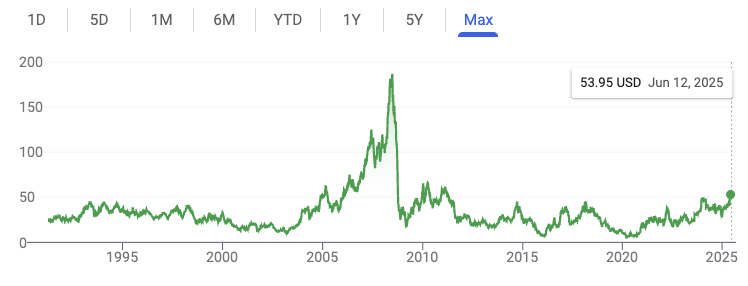We Should Rethink Steel In A Geopolitical World

Steel is no longer just a commodity story; it’s a geopolitical one.
The industry sits squarely at the convergence of politics, industrial strategy, and macroeconomic transformation.
For investors, steel is becoming less about riding volatile price cycles and more about positioning within a broader national agenda:
- economic resilience
- supply chain security, and
- industrial sovereignty
Key Takeaways – Steel Stocks
- Steel is now more squarely a strategic asset class, benefiting from reshoring, industrial policy, and the national push for supply chain resilience.
- Top-performing steel companies exhibit cost efficiency, capital discipline, and durable margins, not just cyclical revenue spikes.
- Tariffs, infrastructure spending, and auto recovery are fueling both short-term momentum and long-term structural demand.
- ETFs and leaders like Nucor and Steel Dynamics offer exposure with quality filters, while global or speculative names require added caution.
Structural and Strategic Forces Are Driving the Steel Rally
Tariffs and Trade Nationalism Are a Renewed Tailwind
Steel has long been a political lever in trade disputes.
And tariffs remain a powerful catalyst for domestic producers.
Whether implemented for national security, anti-dumping, or climate policy reasons, protectionist measures lift margins for US-based firms and discourage foreign supply surges.
When trade policy tightens, steel equities often react before the actual measures take effect.
Infrastructure and Onshoring Fuel Multi-Year Demand
Federal investment in non-residential infrastructure, clean energy, and semiconductor manufacturing is driving real, physical demand for steel.
These initiatives represent a structural shift in how capital is being used across the American economy.
Steel benefits directly from this capital intensity and indirectly from a cultural shift toward domestic manufacturing revival.
Supply Chain Restocking Meets Auto Sector Revival
After years of pandemic-induced inventory depletion, the supply chain is rebuilding.
This restocking cycle is overlapping with a rebound in the automotive sector, which is both credit-sensitive and steel-intensive.
Together, these forces are contributing to a dual momentum: cyclical recovery on top of structural demand.
Shareholder Discipline and Capital Efficiency Are Re-Rating the Sector
Historically, steel has been plagued by boom-bust cycles and capital destruction.
The industry peaked in 2008 and hasn’t recovered even the nominal highs since then.
For example, here’s US Steel’s (X) price chart:

But top players like Nucor and Steel Dynamics are rewriting the script of steel as a low-growth, capital-intensive sector with mediocre investment potential.
Today’s leading producers exhibit strong balance sheets, measured growth, and consistent dividends – traits that are attracting a broader class of investors beyond just cyclical traders and other “hot money” flows.
What Fundamentals Should Investors Prioritize in Steel?
Favor Cost-Efficient Models Like Electric Arc Furnaces (EAFs)
EAF-based steelmakers tend to be more energy-efficient, less capital-intensive, and more adaptable to shifting input prices.
They’re also structurally better suited for decarbonization and circular economy trends, making them future-proof relative to traditional blast furnace operators.
Look for Durable Profitability, Not Just Revenue Growth
Net margins around 5% are a healthy baseline in this industry.
Anything above 7%, if sustainable, signals general operational excellence.
Investors should evaluate whether a company’s profits come from high-value products or just commodity tailwinds.
The former implies pricing power and business quality.
Strong Balance Sheets Mean Resilience Through the Cycle
Look for companies with low net debt, high interest coverage, ample cash reserves, stable working capital, and disciplined capex.
In an industry that historically expands too quickly in good times, financial conservatism can be a competitive advantage.
Prioritize High-ROIC Growth, Not Volume for Its Own Sake
Smart capital allocation beats scale.
Favor firms investing in value-added lines (e.g., galvanizing, electrical steels, or downstream fabrication) where margins are protected and pricing is less volatile.
How to Play the Sector: Key Names & Fund Options
Nucor and Steel Dynamics Lead
Nucor (NUE) and Steel Dynamics (STLD) consistently rank at the top for efficiency, margin stability, and shareholder alignment.
Their EAF-driven models and integrated value chains give them an edge, particularly when policy, ESG, and industrial trends converge.
ArcelorMittal Adds Global Exposure with Caveats
For investors seeking international diversification, ArcelorMittal (MT) offers scale and leverage to European and emerging markets.
However, its performance is more volatile.
It also carries greater exposure to FX swings and policy fragmentation.
US Steel Is a Turnaround Bet, Not a Core Holding
United States Steel (X) is a more speculative position.
Its performance depends on restructuring execution, cost transformation, and occasional M&A headlines.
It requires risk tolerance and having an inside edge in M&A and restructuring (which generally requires a specific skill set).
ETFs Offer Broader Access with Built-In Diversification
For diversified exposure, the VanEck Steel ETF (SLX) offers targeted access to steel producers globally.
Meanwhile, SPDR’s Metals & Mining ETF (XME) includes a broader mix of resource equities, with meaningful steel allocation.
Both provide a convenient way to align with macro themes without single-stock risk.
Where Steel Belongs in a Portfolio Strategy
Steel Fits Within a Real Assets or Inflation-Resilient Sleeve
Steel is a cyclical but tangible asset class: tied to physical investment.
It aligns well with inflation-sensitive or real asset strategies.
By and large, infrastructure, commodities, and materials are underallocated in portfolios.
A tactical overweight makes sense when policymakers are prioritizing physical economy investments.
Be Prepared for Volatility, Especially Globally
The sector remains about 2x more volatile than the broader market and can swing sharply with economic sentiment.
Global players face added risks from currency fluctuations, cross-border trade rules, and political shifts.
Risk-aware position sizing is important because of the higher beta to the market.
Correlated, But With a Thematic Edge
Steel stocks have historically exhibited a strong positive correlation with the S&P 500 (around +0.70).
But what makes them interesting now is how they line up with macro themes that could shape ongoing trends:
- deindustrialization
- deglobalization, and
- the strategic prioritization of national production capacity
The Bigger Picture: Steel as a Strategic Asset Class
Steel isn’t just an input but an indicator.
Its resurgence marks a broader reorientation from a finance-led era toward a real economy revival.
For investors, the sector offers more than tactical upside, but thematic alignment with the forces shaping a new economic order, as we’ve covered in other articles.
Steel equities, when chosen thoughtfully, allow exposure to an emerging playbook: one focused on durability, sovereignty, and productive capital formation.